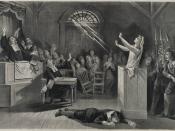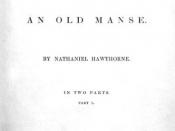In Puritan Massachusetts the key word was suspicion. In order to be accepted, by the community, you had to be a member of
the 'elect,' destined for a spot in the eternity of heaven. In order to be member of this elite group of 'selected' individuals
you had to be free of sin and evil. It goes without saying, that you could never be caught conjuring the devil, as is illustrated
by the horrors of the infamous Salem witch trials. In Young Goodman Brown, and Rappacini's Daughter Nathaniel
Hawthorne portrays two different ways of soliciting or being solicited by the devil. The final scenes in both of these stories
although similar in nature, are actually conflicting in essence, and show the two adverse ways in which people and evil can
become one.
In Young Goodman Brown, the protagonist, Goodman Brown goes off on a typical search for the devil.
The devil is
associated with darkness and terror, a creature only to be sought after while enveloped in the darkness of the night. As
Goodman Brown himself replies to Faith's longing for him to wait until morning to embark on his journey, 'My journey needst
be done twixt now and sunrise' (611). Goodman Brown knows exactly what he is going to look for, he is searching for evil. He
goes to the forest to do his deed and 'he had taken a dreary road darkened by all the gloomiest trees of the forest' to get
there(611). Goodman Brown is willingly seeking the devil, and Hawthorne is throwing in all the stereotypes. This entire
search for the devil is portrayed as being very ugly. What then is pretty? In Young Goodman Brown beauty equals inherent
goodness, or Faith. Young Goodman Brown separates from this righteousness, for evil. From the beginning,


